The NVIDIA GeForce GTX 980 Ti Review
by Ryan Smith on May 31, 2015 6:00 PM ESTOverclocking
Finally, no review of a high-end video card would be complete without a look at overclocking performance.
From a design standpoint, GTX 980 Ti already ships close to its power limits. NVIDIA’s 250W TDP can only be raised another 10% – to 275W – meaning that in TDP limited scenarios there’s not much headroom to play with. On the other hand with the stock voltage being relatively low, in clockspeed limited scenarios there’s still some room for pushing the performance envelope through overvolting. And neither of these options addresses the most potent aspect of overclocking, which is pushing the entire clockspeed curve higher at the same voltages by increasing the clockspeed offsets.
GTX Titan X by comparison ended up being a good overclocker, and while we'd expect GTX 980 Tis to use slightly lower quality chips as part of the binning process, it should still overclock rather well.
| GeForce GTX 980 Ti Overclocking | ||||
| Stock | Overclocked | |||
| Core Clock | 1000MHz | 1250MHz | ||
| Boost Clock | 1075Mhz | 1326MHz | ||
| Max Boost Clock | 1202MHz | 1477MHz | ||
| Memory Clock | 7GHz | 8GHz | ||
| Max Voltage | 1.187v | 1.23v | ||
Overall we're able to get another 250MHz (25%) out of the GTX 980 Ti's GPU, and another 1GHz (14%) out of its VRAM. This pushes the GTX 980 Ti's clockspeeds up to 1326MHz for the standard boost clock, and 1477MHz for the maximum boost clock. The card is heavily TDP limited at this point, so it's unlikely to sustain clockspeeds over 1400MHz, but working clockspeeds in the 1300MHz range are certainly sustainable. Meanwhile interestingly enough, this is actually a slightly better overclock than what we saw with the GTX Titan X; the Titan was only able to get another 200MHz out of its GPU and 800MHz out of its memory. So GTX 980 Ti ends up being the better overclocker by 50MHz.
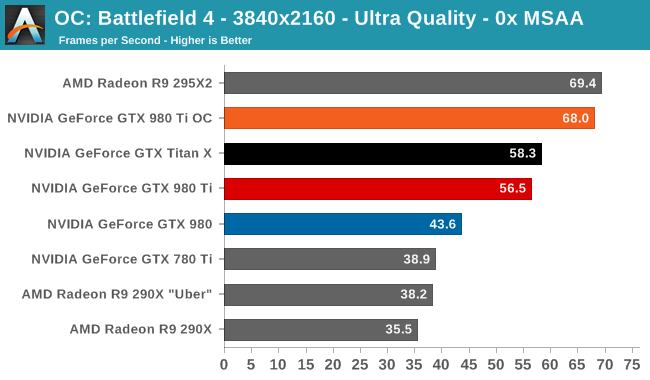
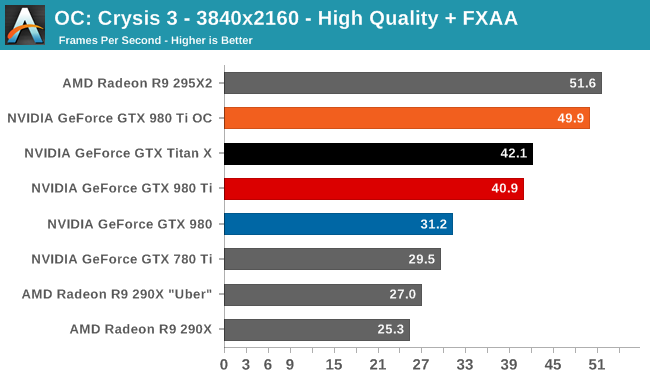
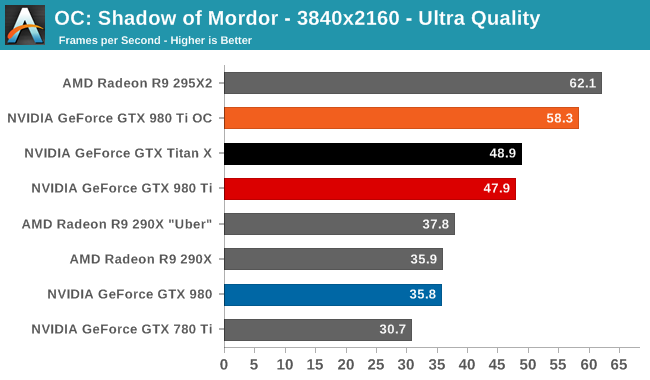
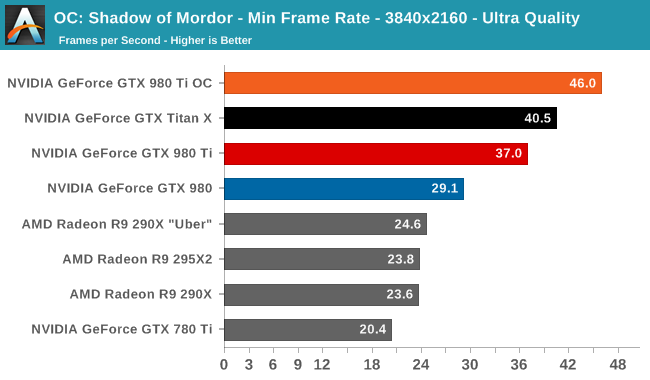
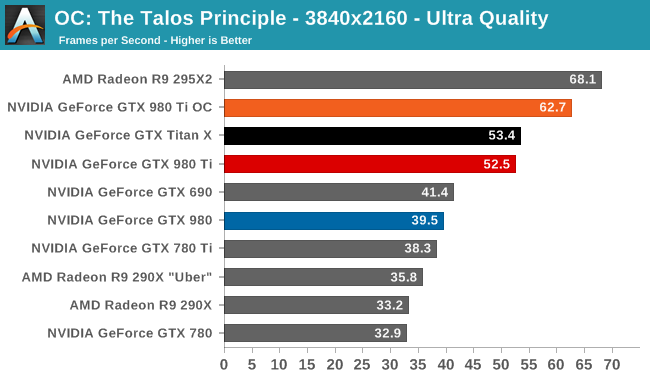
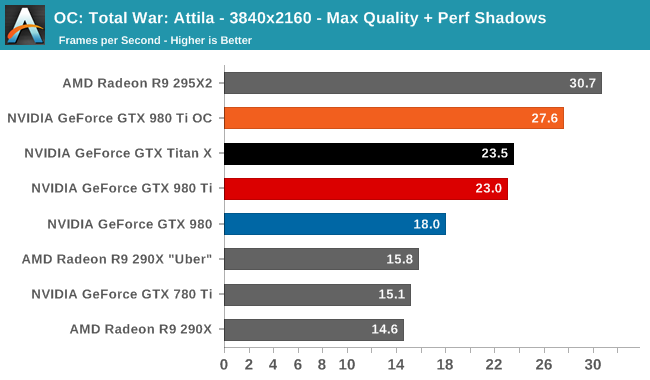
The gains from this overclock are a very consistent across all 5 of our sample games at 4K, with the average performance increase being 20%. Though not quite enough to push the GTX 980 Ti above 60fps in Shadow of Mordor or Crysis 3, it is enough to crack 60fps on Battlefield 4 and The Talos Principle.
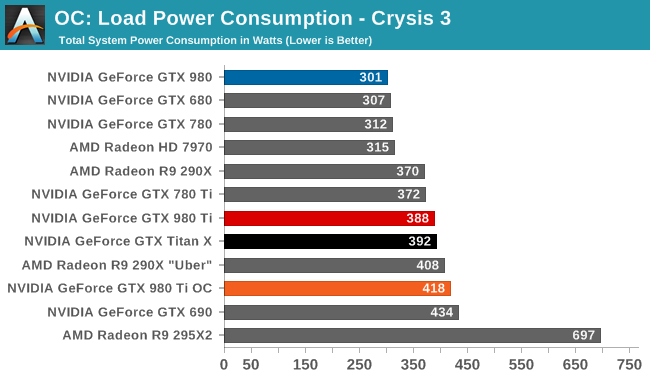
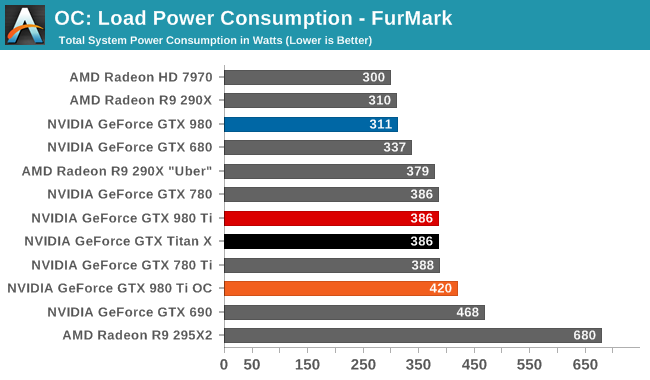
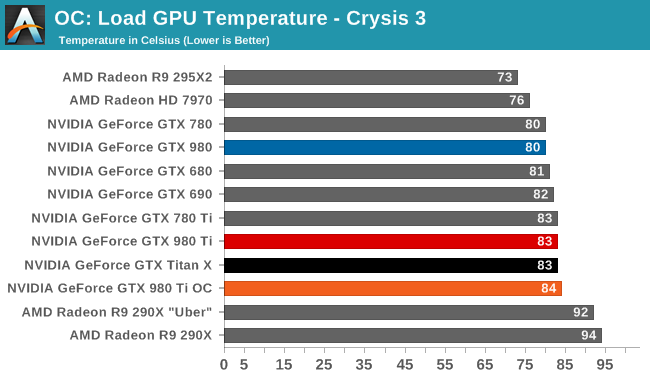
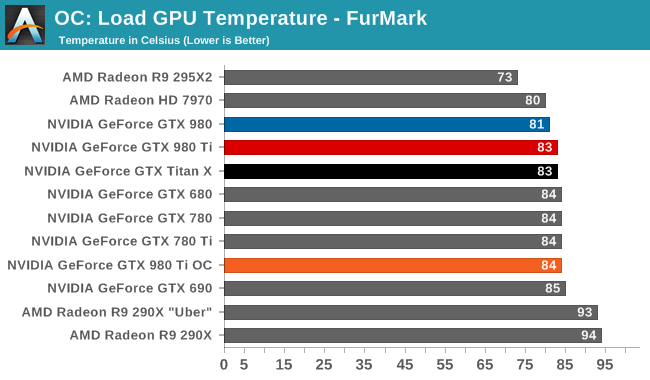
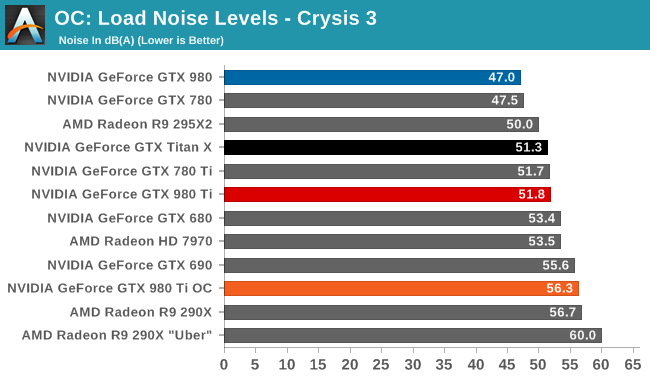
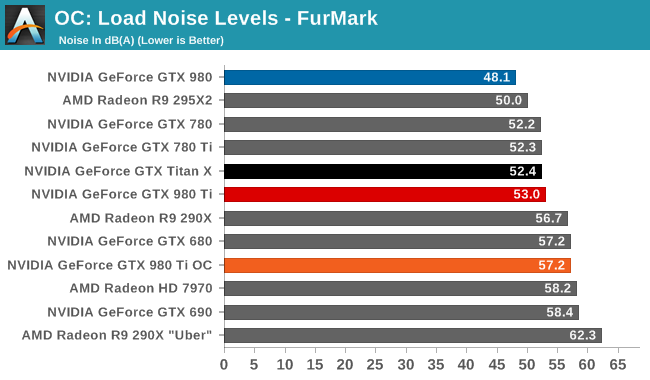
The cost of that 20% overclock in terms of power and noise is similarly straightforward. You're looking at an increased power cost of 30W or so at the wall – in-line with the 25W increase in the card’s TDP – while on the noise front the GTX 980 Ti is pushed out of its sweet spot. Card noise levels will increase by around 4.5dB(A).










290 Comments
View All Comments
chizow - Monday, June 1, 2015 - link
Yes, its unprecedented to launch a full stack of rebrands with just 1 new ASIC, as AMD has done not once, not 2x, not even 3x, but 4 times with GCN (7000 to Boost/GE, 8000 OEM, R9 200, and now R9 300) Generally it is only the low-end, or a gap product to fill a niche. The G92/b isn't even close to this as it was rebranded numerous times over a short 9 month span (Nov 2007 to July 2008), while we are bracing ourselves for AMD rebrands going back to 2011 and Pitcairn.Gigaplex - Monday, June 1, 2015 - link
If it's the 4th time as you claim, then by definition, it's most definitely not unprecedented.chizow - Monday, June 1, 2015 - link
The first 3 rebrands were still technically within that same product cycle/generation. This rebrand certainly isn't, so rebranding an entire stack with last-gen parts is certainly unprecedented. At least, relative to Nvidia's full next-gen product stack. Hard to say though given AMD just calls everything GCN 1.x, like inbred siblings they have some similarities, but certainly aren't the same "family" of chips.Refuge - Monday, June 1, 2015 - link
Thanks Gigaplex, you beat me to it... lolchizow - Monday, June 1, 2015 - link
Cool maybe you can beat each other and show us the precedent where a GPU maker went to market with a full stack of rebrands against the competition's next generation line-up. :)FlushedBubblyJock - Wednesday, June 10, 2015 - link
Nothing like total fanboy denialKevin G - Monday, June 1, 2015 - link
The G92 got its last prebrand in 2009 and was formally replaced on in 2010 by the GTX 460. It had a full three year life span on the market.The GTS/GTX 200 series as mostly rebranded. There was the GT200 chip on the high end that was used for the GTX 260 and up. The low end silently got the GT216 for the Geforce 210 a year after the GTX 260/280 launch. At this time, AMD was busy launching the Radeon 4000 series which brought a range of new chips to market as a new generation.
Pitcairn came out in 2012, not 2011. This would mimic the life span of the G92 as well as the number of rebrands. (It never had a vanilla edition, it started with the Ghz edition as the 7870.)
chizow - Monday, June 1, 2015 - link
@Kevin G, nice try at revisionist history, but that's not quite how it went down. G92 was rebranded numerous times over the course of a year or so, but it did actually get a refresh from 65nm to 55nm. Indeed, G92 was even more advanced than the newer GT200 in some ways, with more advanced hardware encoding/decoding that was on-die, rather than on a complementary ASIC like G80/GT200.Also, at the time, prices were much more compacted at the time due to economic recession, so the high-end was really just a glorified performance mid-range due to the price wars started by the 4870 and the economics of the time.
Nvidia found it was easier to simply manipulate the cores on their big chip than to come out with a number of different ASICs, which is how we ended up with GTX 260 core 192, core 216 and the GTX 275:
Low End: GT205, 210, GT 220, GT 230
Mid-range: GT 240, GTS 250
High-end: GTX 260, GTX 275
Enthusiast: GTX 280, GTX 285, GTX 295
The only rebranded chip in that entire stack is the G92, so again, certainly not the precedent for AMD's entire stack of Rebrandeon chips.
Kevin G - Wednesday, June 3, 2015 - link
@chizowOut of that list of GTS/GTX200 series, the new chip in that line up in 2008 was the GT200 and the GT218 that was introduced over a year later in late 2009. For 9 months on the market the three chips used in the 200 series were rebrands of the G94, rebrands of the G92 and the new GT200. The ultra low end at this time was filled in by cards still carrying the 9000 series branding.
The G92 did have a very long life as it was introduced as the 8800GTS with 512 MB in late 2007. In 2008 it was rebranded the 9800GTX roughly six months after it was first introduced. A year later in 2009 the G92 got a die shrink and rebranded as both the GTS 150 for OEMs and GTS 250 for consumers.
So yeah, AMD's R9 300 series launch really does mimic what nVidia did with the GTS/GTX 200 series.
FlushedBubblyJock - Wednesday, June 10, 2015 - link
G80 was not G92 not G92b nor G94 mr kevin g